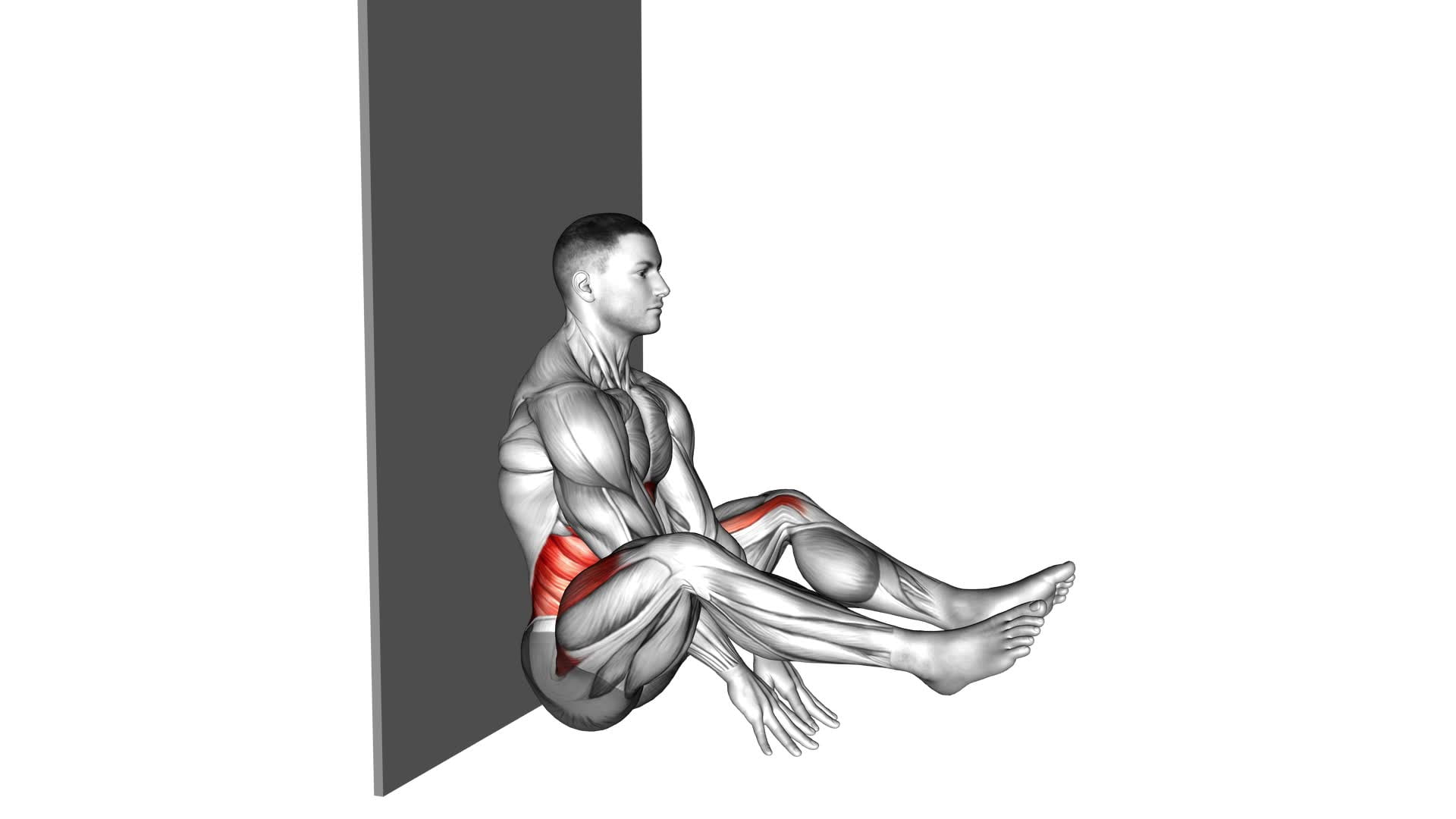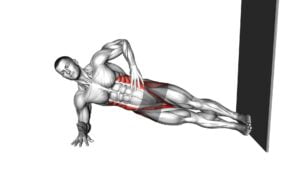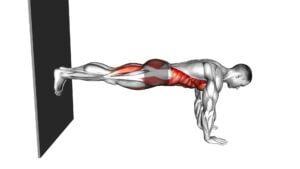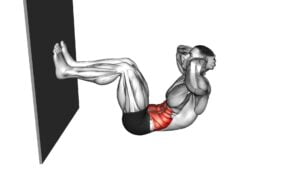V Sit Against Wall (Male) – Video Exercise Guide & Tips

Looking to strengthen your core and improve your posture? Look no further than the V Sit Against Wall exercise.
Watch This Exercise Video
This video exercise guide and tips will show you how to properly perform the V Sit Against Wall, along with variations and progressions to challenge yourself.
Avoid common mistakes and get ready for success with these helpful tips.
Get ready to sit against that wall and feel the burn!
Key Takeaways
- The V sit against wall exercise improves core strength and engages various muscles including the abdominal muscles, obliques, and lower back.
- Proper form and technique are crucial for this exercise, including sitting with the back against the wall, keeping the legs extended and straight, and engaging the core by pulling the belly button towards the spine.
- There are variations and progressions of the V sit against wall exercise, such as lifting one leg off the ground, extending arms overhead, using a stability ball for support, and incorporating advanced modifications and props.
- It is important to avoid common mistakes like slouching or rounding the back, not engaging the core properly, relying on momentum instead of abdominal muscles, and placing the feet too high or too low on the wall. It is also important to focus on deep breathing, incorporate regular stretching exercises, include other core and lower body exercises, and listen to the body for successful results.
Benefits of V Sit Against Wall
You can experience numerous benefits from practicing the V Sit Against Wall exercise. This exercise is highly effective in improving core strength and increasing flexibility. By sitting against the wall in a V-shaped position, you engage and strengthen your abdominal muscles, obliques, and lower back. The isometric contraction of these muscles helps to stabilize your spine and improve your overall posture.
Additionally, the V Sit Against Wall exercise targets your hip flexors and hamstrings, resulting in increased flexibility in these areas. This can be particularly beneficial for athletes, as it enhances performance and reduces the risk of injury. Moreover, this exercise also activates your glutes, which helps to tone and strengthen your buttocks.
Proper Form and Technique
To perform the V Sit Against Wall exercise with proper form and technique, begin by positioning yourself against the wall. Here are some important tips to ensure you're performing the exercise correctly:
- Maintain proper alignment: Sit on the floor with your back against the wall, keeping your legs extended and straight in front of you. Your body should form a V shape.
- Engage your core: Throughout the exercise, remember to engage your core muscles by pulling your belly button towards your spine. This will help stabilize your body and protect your lower back.
- Keep your shoulders relaxed: Avoid shrugging your shoulders or tensing them up. Keep them relaxed and away from your ears.
- Breathe properly: Inhale deeply as you prepare to lift your legs off the ground, and exhale as you slowly lower them back down. Focus on maintaining a steady and controlled breathing pattern.
Variations and Progressions
Explore different variations and progressions of the V Sit Against Wall exercise to challenge your core muscles and enhance your strength and stability. Once you have mastered the basic form and technique, you can advance your practice by incorporating advanced modifications and using props.
To make the V Sit Against Wall exercise more challenging, you can try lifting one leg off the ground while maintaining the V-shaped position. This will engage your core even further and increase the demand on your stability. Another variation is to extend your arms overhead while holding the V position, adding an extra element of balance and strength.
Incorporating props can also enhance the difficulty of the exercise. You can use a stability ball to perform the V Sit Against Wall, placing it against your lower back for added support. This will require more control and stability as you engage your core to maintain balance.
By exploring these advanced modifications and incorporating props, you can continue to challenge your core muscles and improve your overall strength and stability.
Now that you have learned about different variations and progressions of the V Sit Against Wall exercise, it's important to be aware of common mistakes to avoid.
Common Mistakes to Avoid
When performing the V Sit Against Wall exercise, it's important to be aware of common mistakes to avoid. Proper technique is crucial to ensure you get the most out of this exercise and prevent any potential injuries. Here are some common mistakes to watch out for:
- Slouching or rounding your back: Maintaining proper posture is essential during the V Sit Against Wall exercise. Avoid slouching or rounding your back, as this puts unnecessary strain on your spine and diminishes the effectiveness of the exercise.
- Not engaging your core: The V Sit Against Wall exercise primarily targets your core muscles. Failing to engage your core properly can lead to a lack of stability and reduced effectiveness. Be sure to actively contract your abdominal muscles throughout the exercise.
- Using momentum: Avoid using momentum to lift your legs and upper body off the ground. Instead, focus on using your abdominal muscles to control the movement. This will help you build strength and stability in your core.
- Placing your feet too high or too low on the wall: To achieve the proper V shape, ensure that your feet are positioned at a height on the wall that allows your legs to be straight and parallel to the ground. Placing your feet too high or too low can compromise the exercise and limit its effectiveness.
Tips for a Successful V Sit Against Wall
Maintain proper form and engage your core muscles for a successful V Sit Against Wall. To ensure proper breathing during this exercise, focus on taking deep breaths in and out. Inhale as you lower your legs and exhale as you lift them back up. This will help you maintain control and stability throughout the movement.
Flexibility is key when performing a V Sit Against Wall. To increase flexibility, incorporate regular stretching exercises into your routine. Focus on stretching your hamstrings, hip flexors, and lower back. Stretching before and after your workout can help improve your range of motion and prevent injury.
Additionally, consider incorporating exercises that target your core and lower body. Planks, leg raises, and squats are great exercises that can help strengthen the muscles needed for a successful V Sit Against Wall. By building strength in these areas, you'll be able to maintain the V position for a longer period of time.
Remember to listen to your body and take breaks when needed. Pushing yourself too hard can lead to muscle strain or injury. With proper form, breathing techniques, and flexibility training, you'll be able to perform a successful V Sit Against Wall and strengthen your core muscles effectively.
Frequently Asked Questions
How Long Should I Hold the V Sit Against the Wall Position?
To get the most out of the V sit against the wall exercise, it's important to know how long to hold the position. Without considering the specific details of the exercise guide, the length of time you should hold the V sit against the wall will depend on your fitness level and goals.
Beginners might start with shorter holds, around 10-15 seconds, gradually increasing as they get stronger. Holding the position for 30 seconds to a minute is a good goal for building core strength.
Can I Do the V Sit Against the Wall Exercise if I Have Lower Back Pain?
If you're experiencing lower back pain, it's important to modify the V sit against wall exercise. Instead, try doing modified variations that put less strain on your lower back.
You can also explore alternative exercises that target the same muscles without aggravating your pain.
It's crucial to listen to your body and work within your comfort level to prevent further injury.
Consulting with a healthcare professional or a qualified trainer can provide you with personalized guidance.
Is It Necessary to Warm up Before Attempting the V Sit Against the Wall Exercise?
Before attempting the V sit against the wall exercise, it's necessary for you to warm up. Warming up has many benefits, such as increasing blood flow to your muscles and reducing the risk of injury.
If you have lower back pain and can't perform this exercise, there are alternative exercises you can try, such as seated forward folds or modified crunches.
Remember to always listen to your body and consult with a healthcare professional if needed.
Can I Do the V Sit Against the Wall Exercise if I Have Tight Hamstrings?
If you have tight hamstrings, you may still be able to do the V sit against the wall exercise. It can help improve your flexibility over time. However, it's important to start slowly and listen to your body.
You may need to modify the exercise by bending your knees or placing a rolled-up towel under your knees for support.
The V sit against the wall has many variations and can benefit your core strength and posture.
How Often Should I Incorporate the V Sit Against the Wall Exercise Into My Workout Routine?
To effectively incorporate the V sit against the wall exercise into your workout routine, it's important to consider the benefits it offers. This exercise targets your core, hip flexors, and hamstrings, improving your overall strength and flexibility.
As for how often you should do it, aim for 2-3 times a week. Start with a few sets and gradually increase the number as you become more comfortable. Remember to listen to your body and adjust accordingly.
Conclusion
Incorporating the V Sit Against Wall exercise into your routine can bring numerous benefits, such as improved core strength and posture. Remember to maintain proper form and technique, and feel free to explore variations and progressions as you become more comfortable.
Avoid common mistakes like slouching or relying solely on your arms. Follow these tips for a successful V Sit Against Wall and enjoy the results of this effective exercise.

Author
Years ago, the spark of my life’s passion ignited in my mind the moment I stepped into the local gym for the first time. The inaugural bead of perspiration, the initial endeavor, the very first surge of endorphins, and a sense of pride that washed over me post-workout marked the beginning of my deep-seated interest in strength sports, fitness, and sports nutrition. This very curiosity blossomed rapidly into a profound fascination, propelling me to earn a Master’s degree in Physical Education from the Academy of Physical Education in Krakow, followed by a Sports Manager diploma from the Jagiellonian University. My journey of growth led me to gain more specialized qualifications, such as being a certified personal trainer with a focus on sports dietetics, a lifeguard, and an instructor for wellness and corrective gymnastics. Theoretical knowledge paired seamlessly with practical experience, reinforcing my belief that the transformation of individuals under my guidance was also a reflection of my personal growth. This belief holds true even today. Each day, I strive to push the boundaries and explore new realms. These realms gently elevate me to greater heights. The unique combination of passion for my field and the continuous quest for growth fuels my drive to break new ground.







